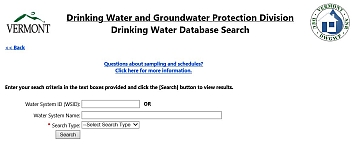Water systems are responsible for conducting monitoring of drinking water to ensure that it meets all drinking water standards as determined by its monitoring schedule which can be checked via the Drinking Water Database Search Tool. The frequency of monitoring is often dependent on the contaminant, and the population served by the public water system.
Public water systems serving large populations generally require more monitoring because of the greater potential impact of violations.
Primary standards protect public health by limiting the levels of contaminants in drinking water. For a complete list of primary contaminants see Table 6-1 of the Water Supply Rule.
Secondary standards protect public health by limiting the color, taste, odor, and visual appearance of the drinking water that my cause consumers not to drink or use the water, even when it is actually safe to drink. For a complete list of secondary contaminants, refer to Section 6.13 of the Water Supply Rule. Also, refer to additional state and federal rules.
Laboratories analyzing drinking water compliance samples must be certified by Vermont Department of Health for the appropriate test method and analyte. More information on certified laboratory requirements and the up-to-date list of certified labs is available.
It is the responsibility of the water system to make sure sampling results are reported to the Division in a timely manner even if a lab offers automatic electronic data submission. If results do not appear on the monitoring schedule website within two weeks of you receiving the results from the lab, forward a copy of your lab report to the Division using this email: ANR.DWData@vermont.gov.
Refer to the Chemical Sampling Frequency Table for specific monitoring information.
Please see below for more information on specific contaminants and constituent groups:
- Asbestos
- Chemical Contaminants
- Cryptosporidium (surface water only)
- Cyanotoxins-Cyanobacteria
- Disinfection Byproducts
- Lead and Copper
- Manganese
- Total Coliform/E. Coli
- Turbidity (surface water only)
- Radionuclides
Microscopic Particulate Analysis (MPA) is used to determine if a Groundwater Source is Under the Direct Influence of surface water (GWUDI). For more information, visit the Source Water Protection page.
See the list of laboratories that perform microscopic particulate analysis (MPA) testing.
Annual Water Quality Compliance Reports
2023 Annual Water Quality Compliance Report
2022 Annual Water Quality Compliance Report
2021 Annual Water Quality Compliance Report
2020 Annual Water Quality Compliance Report
2019 Annual Water Quality Compliance Report
2018 Annual Water Quality Compliance Report
2017 Annual Water Quality Compliance Report
2016 Annual Water Quality Compliance Report
2015 Annual Water Quality Compliance Report
2014 Annual Water Quality Compliance Report
2013 Annual Water Quality Compliance Report
2012 Annual Water Quality Compliance Report
2011 Annual Water Quality Compliance Report
2010 Annual Water Quality Compliance Report
2009 Annual Water Quality Compliance Report
2007 Annual Water Quality Compliance Report
2006 Annual Water Quality Compliance Report
2005 Annual Water Quality Compliance Report


